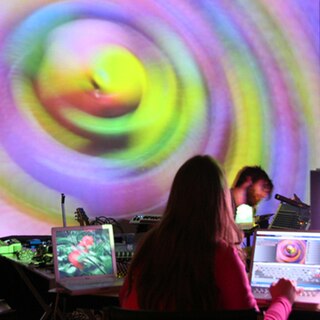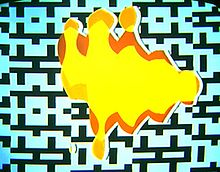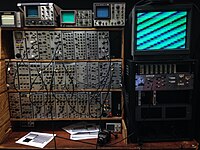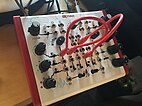
Modular synthesizers are synthesizers composed of separate modules for different functions. The modules can be connected together by the user to create a patch. The outputs from the modules may include audio signals, analog control voltages, or digital signals for logic or timing conditions. Typical modules are voltage-controlled oscillators, voltage-controlled filters, voltage-controlled amplifiers and envelope generators.

Component video is an analog video signal that has been split into two or more component channels. In popular use, it refers to a type of component analog video (CAV) information that is transmitted or stored as three separate signals. Component video can be contrasted with composite video in which all the video information is combined into a single signal that is used in analog television. Like composite, component cables do not carry audio and are often paired with audio cables.
Scanimate is an analog computer animation system developed from the late 1960s to the 1980s by Computer Image Corporation of Denver, Colorado.

The Roland MT-32 Multi-Timbre Sound Module is a MIDI synthesizer module first released in 1987 by Roland Corporation. It was originally marketed to amateur musicians as a budget external synthesizer with an original list price of $695. However, it became more famous along with its compatible modules as an early de facto standard in computer music. Since it was made prior to the release of the General MIDI standard, it uses its own proprietary format for MIDI file playback.
Electronic Music Studios (EMS) is a synthesizer company formed in Putney, London in 1969 by Peter Zinovieff, Tristram Cary and David Cockerell. It is now based in Ladock, Cornwall.

The Korg OASYS is a workstation synthesizer released in early 2005, 1 year after the successful Korg Triton Extreme. Unlike the Triton series, the OASYS uses a custom Linux operating system that was designed to be arbitrarily expandable via software updates, with its functionality limited only by the PC-like hardware.

A composite monitor or composite video monitor is any analog video display that receives input in the form of an analog composite video signal to a defined specification. A composite video signal encodes all information on a single conductor; a composite cable has a single live conductor plus earth. Other equipment with display functionality includes monitors with more advanced interfaces and connectors giving a better picture, including analog VGA, and digital DVI, HDMI, and DisplayPort; and television (TV) receivers which are self-contained, receiving and displaying video RF broadcasts received with an internal tuner. Video monitors are used for displaying computer output, closed-circuit television and other applications requiring a two-dimensional monochrome or colour image.
In a mixed-signal system, a reconstruction filter, sometimes called an anti-imaging filter, is used to construct a smooth analog signal from a digital input, as in the case of a digital to analog converter (DAC) or other sampled data output device.

The Sandin Image Processor is a video synthesizer, usually introduced as invented by Dan Sandin and designed between 1971 and 1974. Some called it the "video equivalent of a Moog audio synthesizer." It accepted basic video signals and mixed and modified them in a fashion similar to what a Moog synthesizer did with audio. An analog, Modular Synthesizer, real time, video processing instrument, it provided video processing performance and produced subtle and delicate video effects of a complexity not seen again until well into the digital video revolution.
William Etra was a live video pioneer and the co-inventor of the Rutt/Etra Video Synthesizer.

Sound Blaster Live! is a PCI add-on sound card from Creative Technology Limited for PCs. Moving from ISA to PCI allowed the card to dispense with onboard memory, storing digital samples in the computer's main memory and then accessing them in real time over the bus. This allowed for a much wider selection of, and longer playing, samples. It also included higher quality sound output at all levels, quadrophonic output, and a new MIDI synthesizer with 64 sampled voices. The Live! was introduced in August 1998 and variations on the design remained Creative's primary sound card line into the early 2000's.

VJing is a broad designation for realtime visual performance. Characteristics of VJing are the creation or manipulation of imagery in realtime through technological mediation and for an audience, in synchronization to music. VJing often takes place at events such as concerts, nightclubs, music festivals and sometimes in combination with other performative arts. This results in a live multimedia performance that can include music, actors and dancers. The term VJing became popular in its association with MTV's Video Jockey but its origins date back to the New York club scene of the 1970s. In both situations VJing is the manipulation or selection of visuals, the same way DJing is a selection and manipulation of audio.

Daniel J. Sandin is an American video and computer graphics artist, designer and researcher. He is a Professor Emeritus of the School of Art & Design at University of Illinois at Chicago, and co-director of the Electronic Visualization Laboratory (EVL) at the University of Illinois at Chicago. He is an internationally recognized pioneer in computer graphics, electronic art and visualization.

Steina Vasulka and Woody Vasulka are early pioneers of video art, and have been producing work since the early 1960s. The couple met in the early 1960s and moved to New York City in 1965, where they began showing video art at the Whitney Museum and founded The Kitchen in 1971. Steina and Woody both became Guggenheim fellows: Steina in 1976, and Woody in 1979.
Phil Morton (1945–2003) was an influential American video artist and activist who founded the Video Area in 1970 at the School of the Art Institute of Chicago, where he taught for many years.

The Rutt/Etra Video Synthesizer is an analog raster manipulation device for image processing and real-time animation. The Rutt/Etra was co-invented by Steve Rutt and Bill Etra.
The Bell Labs Digital Synthesizer, better known as the Alles Machine or Alice, was an experimental additive synthesizer designed by Hal Alles at Bell Labs during the 1970s. The Alles Machine used computer-controlled 16-bit digital synthesizer operating at 30k samples/sec with 32 sine-wave oscillators. The Alles Machine has been called the first true digital additive synthesizer, following on earlier Bell experiments that were partially or wholly implemented as software on large computers. Only one full-length composition was recorded for the machine, before it was disassembled and donated to Oberlin Conservatory's TIMARA department in 1981. Several commercial synthesizers based on the Alles design were released during the 1980s, including the Atari AMY sound chip.

Experimental Television Center is a 501(c)(3) nonprofit electronic and media art center.

The Video Noisefields (1974) by Steina and Woody Vasulka is an important example of early formal and technical experimentation with analog video. The video runs for twelve minutes and five seconds and materially visualizes the deflected energy of the electronic signal. The video switches between two sources throughout, which creates a flickering effect. The imagery is based on the deflection of electronic signals, and a colorizer is used to add color variation. In the video, a circular form materializes on the screen and presents a division between inner and outer. A pulsation between the two is sustained throughout.

A sound chip is an integrated circuit (chip) designed to produce audio signals through digital, analog or mixed-mode electronics. Sound chips are typically fabricated on metal–oxide–semiconductor (MOS) mixed-signal chips that process audio signals. They normally contain audio components such as oscillators, envelope controllers, samplers, filters, amplifiers, and envelope generators.


















